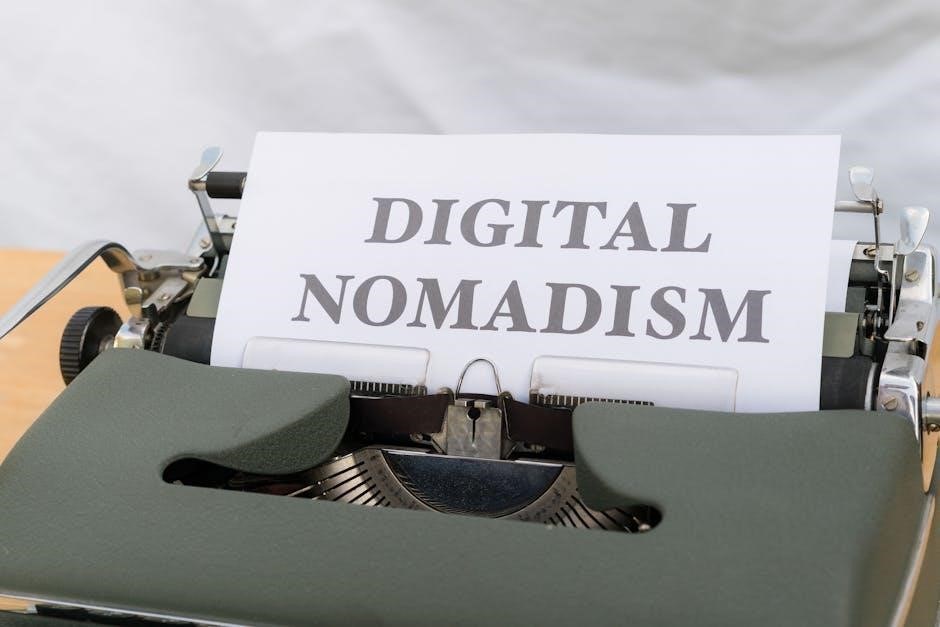
A recommendation letter for a coworker is a structured endorsement of their skills and work ethic, often used for job applications or academic pursuits․ PDF templates provide a professional format, ensuring clarity and organization in highlighting their qualifications and contributions․
Understanding the Purpose and Importance
A recommendation letter for a coworker serves as a personal and professional endorsement, highlighting their skills, work ethic, and contributions․ Its purpose is to provide credibility and support for job applications, academic pursuits, or career advancement․ The letter underscores the coworker’s strengths and reliability, offering insights into their collaboration skills and problem-solving abilities․ It is a crucial document that helps employers or academic institutions assess the candidate’s potential․ Using a PDF template ensures a polished and professional presentation, making the recommendation more impactful and easier to share․
When to Use a Recommendation Letter for a Coworker
A recommendation letter for a coworker is typically used during significant career transitions, such as job applications, academic admissions, or internal promotions․ It is also valuable for freelance opportunities or business partnerships․ The letter provides insights into the coworker’s professional abilities, teamwork skills, and personal qualities․ Employers and academic institutions rely on these letters to assess a candidate’s suitability and potential․ Using a PDF template ensures the letter is well-structured and easily shareable, making it a professional and efficient way to endorse a coworker․
Key Elements of a Coworker Recommendation Letter
A coworker recommendation letter should include an introduction, body highlighting skills and achievements, and a conclusion with contact information, ensuring a clear and professional endorsement using PDF templates․
A strong introduction sets the tone for the recommendation letter, beginning with a formal greeting and stating the purpose of the letter․ Clearly mention your relationship with the coworker, such as their role and how long you’ve worked together․ Express enthusiasm for endorsing them and highlight their key strengths․ A well-crafted opening establishes credibility and provides context, making the letter professional and impactful․ Use a PDF template to ensure proper formatting and a polished presentation․
Body: Highlighting Skills, Achievements, and Work Ethic
The body of the letter should detail the coworker’s skills, achievements, and work ethic․ Use specific examples, such as successful projects or leadership roles, to illustrate their capabilities․ Mention measurable accomplishments, like efficiency improvements or innovative solutions they implemented․ Highlight soft skills like teamwork, communication, and problem-solving․ Emphasize their reliability and dedication, providing anecdotes that showcase their character․ This section should be concise yet comprehensive, ensuring the coworker’s strengths are clearly articulated in the PDF format․
The conclusion summarizes the coworker’s exceptional qualities and reaffirms enthusiasm for their recommendation․ Express confidence in their future success and offer to provide further information․ Include your contact details, such as phone number and email, to facilitate follow-up․ Ensure the PDF format maintains professional formatting, with clear sections and readable fonts, making it easy for recipients to review and contact you if needed․ This final section ties the letter together, leaving a lasting impression of your coworker’s value․

Guidelines for Writing an Effective Recommendation Letter
A well-structured, professional letter highlighting the coworker’s strengths, work ethic, and contributions․ Use specific examples and templates for clarity and effectiveness․
Crafting a Strong Opening
A strong opening sets the tone for the recommendation letter․ Begin by addressing the recipient formally, expressing enthusiasm for the coworker․ Clearly state your relationship, such as “I am writing to wholeheartedly recommend [Coworker’s Name], with whom I have worked closely for [X] years․” Highlight their exceptional qualities, work ethic, and key achievements․ Be specific and positive, ensuring the opening grabs attention and establishes credibility․ Avoid vague language and focus on their strengths and contributions․ This sets a professional and compelling tone for the rest of the letter․
Specific Examples and Anecdotes
Including specific examples and anecdotes enhances the recommendation letter’s credibility․ Describe a time when the coworker excelled, such as leading a project or solving a critical issue․ For instance, mention how they reduced system latency by 38% or improved team collaboration․ Use concrete details to illustrate their skills, like “During a challenging deadline, [Coworker’s Name] effectively coordinated tasks, ensuring timely delivery․” These examples provide tangible evidence of their capabilities and character, making the recommendation more impactful and personal․ Avoid vague statements by focusing on measurable outcomes and personal observations․

Using Templates for a Coworker Recommendation Letter
Templates streamline the writing process, providing a structured format to highlight a coworker’s strengths and achievements․ They ensure consistency, professionalism, and ease of customization for various needs․
Benefits of Using a Template
Using a template for a coworker recommendation letter offers numerous advantages․ It saves time by providing a prestructured format, ensuring all essential sections are included․ Templates promote professionalism, maintaining a polished and consistent appearance․ They also reduce the risk of omitting critical details, such as the coworker’s skills, achievements, and work ethic․ Additionally, templates allow for easy customization, enabling you to tailor the letter to your coworker’s specific qualities and the recipient’s requirements․ This makes the recommendation more personal and impactful while retaining a formal tone․
How to Customize a Template
Customizing a recommendation letter template involves tailoring it to highlight your coworker’s unique strengths and achievements․ Start by replacing placeholder text with specific details about their role, skills, and contributions․ Include anecdotes or examples that showcase their work ethic and accomplishments․ Adjust the tone to match your relationship and the purpose of the recommendation․ Ensure all contact information is accurate and professional․ Finally, proofread the letter to maintain clarity and coherence, making it a compelling endorsement of your coworker’s qualifications․
Sample Letters and Examples
Sample letters provide a framework for crafting effective recommendations, offering inspiration and guidance․ They showcase proper structure, tone, and content, helping you create personalized endorsements for your coworker․
Reviewing Sample Letters for Inspiration
Reviewing sample letters for inspiration is a great way to understand the structure, tone, and content of effective recommendation letters․ These examples provide a clear framework, showcasing how to highlight a coworker’s strengths, achievements, and professional qualities․ By examining sample letters, you can identify key elements to include, such as specific accomplishments, interpersonal skills, and contributions to projects․ This helps in organizing your thoughts and ensuring your letter is both personalized and professional․
Adapting Samples to Fit Your Needs
Adapting sample recommendation letters allows you to tailor the content to your coworker’s unique qualities and achievements․ Start by selecting a template that aligns with your coworker’s role and industry․ Customize the language to reflect their specific contributions, skills, and work ethic․ Personalize the letter by including anecdotes or specific projects that highlight their strengths․ This ensures the recommendation is authentic and relevant, making it more impactful for the recipient․ Avoid generic phrases and ensure the tone matches your professional relationship․

Common Mistakes to Avoid
Avoid vague language and ensure the letter is specific about your coworker’s skills and achievements․ Never include negative comments or unprofessional remarks, as they undermine credibility․
Overly Vague Language
Using overly vague language in a recommendation letter can weaken its impact․ Phrases like “hard worker” or “nice person” lack specificity and fail to highlight unique qualities․ Instead, focus on concrete examples and quantifiable achievements, such as “led a project that increased efficiency by 20%” or “consistently met tight deadlines․” Specific details demonstrate credibility and provide a clearer picture of your coworker’s strengths, making the recommendation more persuasive and meaningful to the recipient․
Negative or Unprofessional Comments
Negative or unprofessional comments in a recommendation letter can harm your coworker’s chances and damage your credibility․ Avoid criticism or complaints about their work habits, attitude, or personal issues․ Phrases like “struggled with teamwork” or “had difficulty meeting deadlines” can undermine their application․ Instead, focus on positive attributes and accomplishments․ If you cannot provide a genuine endorsement, it is better to politely decline the request․ Maintain professionalism and avoid any language that could be perceived as biased or unfair․

Finalizing and Sharing the Letter
After proofreading and editing, convert the recommendation letter to a professional PDF format․ Ensure all contact information is accurate before sharing it with your coworker or the intended recipient․
Proofreading and Editing
Proofreading and editing are essential steps to ensure the recommendation letter is polished and professional․ Review the document for grammar, spelling, and punctuation errors․ Ensure the content flows logically and clearly highlights your coworker’s strengths․ Check for consistency in formatting, such as dates and contact information․ Read the letter aloud to catch any awkward phrasing․ Finally, consider having a trusted colleague or mentor review it to provide feedback and ensure it effectively conveys your endorsement․
Converting to PDF Format
Converting your recommendation letter to PDF format ensures it is presented professionally and maintains its formatting across devices․ Use software like Adobe Acrobat or free online tools to convert your document․ Ensure the PDF is clear and readable, with all text and signatures visible․ This format is widely accepted and preserves the letter’s integrity, making it easy to share via email or upload to applications․ A PDF also adds a level of security and professionalism to your endorsement․